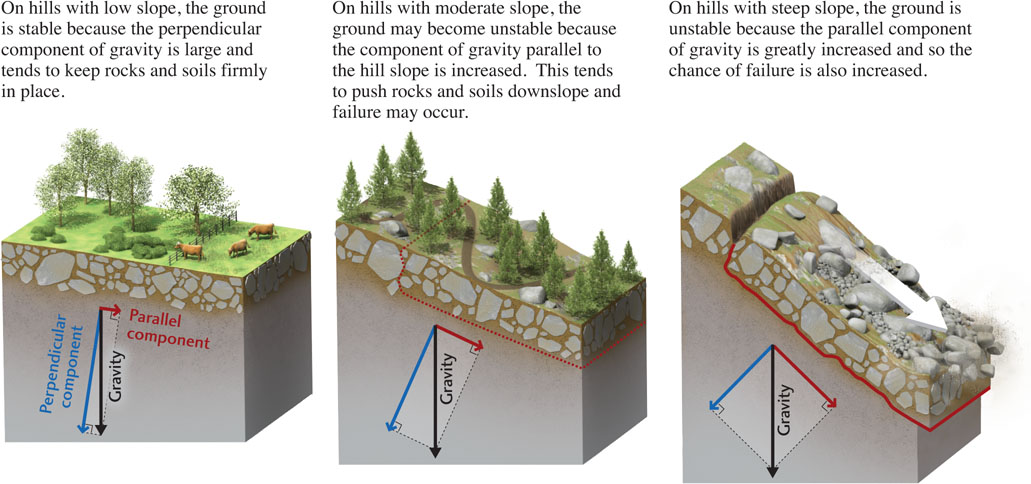Practicing Geology Exercise
What Makes a Slope Too Unstable to Build On?

How can the destruction of homes and other buildings by landslides be avoided? Landslides are most likely in areas where steep topography coincides with other key factors, such as episodic heavy rainfall or earthquakes. Understanding the risk associated with buying or building a home in such areas begins with an assessment of the terrain and its likelihood to undergo mass wasting. Geologists play an important role in making such assessments and in advising potential homeowners and local planners about what kinds of real estate are more likely than others to experience a landslide.
Intuition tells us that if we build a structure on a slope that is too steep, it will slide downhill. Recall the pile of sand we described in the text: as the pile gets steeper, less of it stays in place, and at some point, no matter how much sand we put on the pile, it will just keep slip-sliding away. The same thing is true of masses of soil and rock. They, too, will slide downhill if the slope gets too steep. The important question is, how steep is too steep? We use the three primary factors involved in mass movements to determine which slopes are too steep to build on.
466
The most important factor is the steepness of the slope. Other things being equal, a structure on a steeper slope will slide sooner than a structure of the same size on a gentler slope. The second most important factor is the nature of the slope materials. The better these materials stick together, the more stable the slope will be. The third factor is the presence of water in the slope materials. During heavy rainfall, soil and rock absorb water, their cohesiveness is reduced, and a landslide may be triggered, as some homeowners in Southern California discovered in 2005 (see the chapter opening photo and Figure 16.12).
The accompanying diagram illustrates the forces acting on a mass of soil or rock—a potential slide mass. The main force responsible for mass movements is gravity. Gravity acts everywhere on Earth’s surface, pulling everything toward the center of Earth. When the slide mass rests on a horizontal surface, gravity exerts a downward force on it, holding it firmly in place. On a slope, however, the force of gravity is directed across the base of the slide mass at an angle because gravity pulls toward the center of Earth, no matter what the position of the slide mass is. In this case, the force of gravity can be divided into two components: a force perpendicular to the base of the slide mass and a force parallel to its base.
What do these forces tell us about the likelihood of a landslide? The parallel component of gravity creates shear stress parallel to the base of the slide mass, which pulls it in the downslope direction. The perpendicular component of gravity, known as shear strength, acts to resist the mass’s downward slide. Friction at the base of the slide mass and cohesion between the particles of the slide mass contribute to shear strength.
Sliding tends to occur on steeper slopes because shear stress increases and shear strength decreases. When shear stress becomes greater than shear strength, the mass will slide downslope. Thus, landslides are most likely where shear stress is high (on steeper slopes) and shear strength is low (as on a slope saturated by high rainfall).
A simple equation known as the safety factor, Fs, can be used to predict where and when mass movement will occur:

If the safety factor for a slope is less than 1, then mass movement is expected to occur there.
We can consult Tables A and B for values of shear strength and shear stress to determine which combinations of slope steepness and slope material would provide safe building sites.
Table A
| Slope | Shear Stress |
|---|---|
| 5° | 1 |
| 20° | 5 |
| 30° | 25 |
Table B
| Material | Shear Strength |
|---|---|
| Loose soil | 3 |
| Slate | 10 |
| Granite | 50 |
Let’s calculate the safety factor for a building site on slate on a moderate slope of 20°.

The slope is expected to be stable, but not by much. In many municipalities, this slope would be considered so marginally stable that it might not be permitted for building without meeting extremely expensive engineering standards.
BONUS PROBLEM: Fill in the blanks in Table C for the remaining combinations of slope and material (e.g., starting with a 5° slope on loose soil). Which slopes would be stable enough to build on?
Table C
| Safety Factor (Fs) | |||
|---|---|---|---|
| Loose | Soil | Slate | Granite |
| 5° | ____ | ____ | ____ |
| 20° | ____ | ____ | ____ |
| 30° | ____ | ____ | ____ |